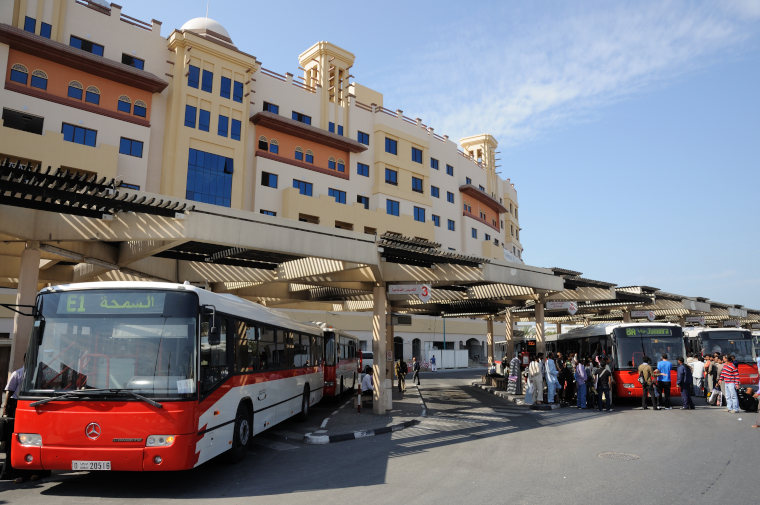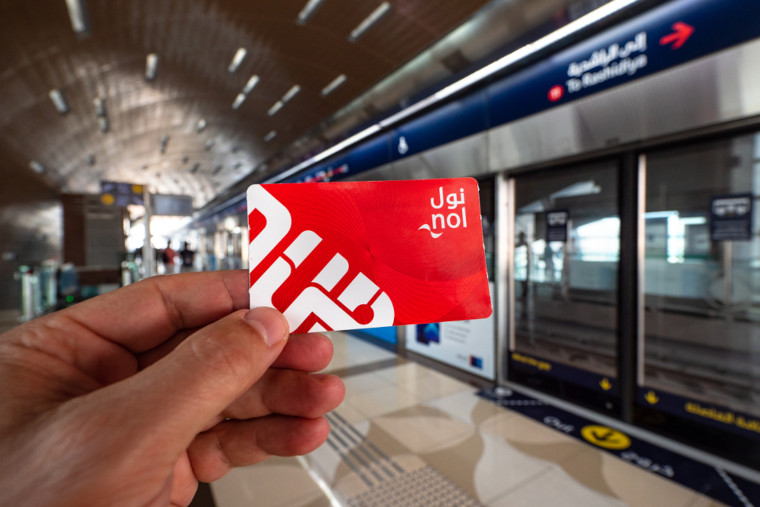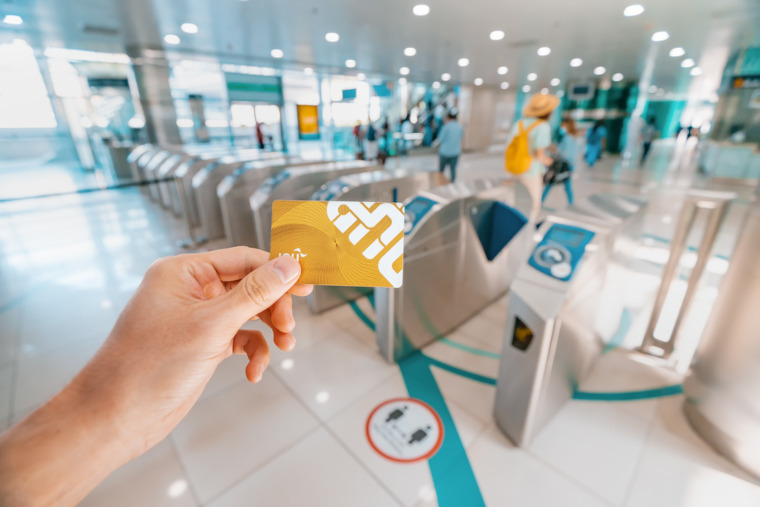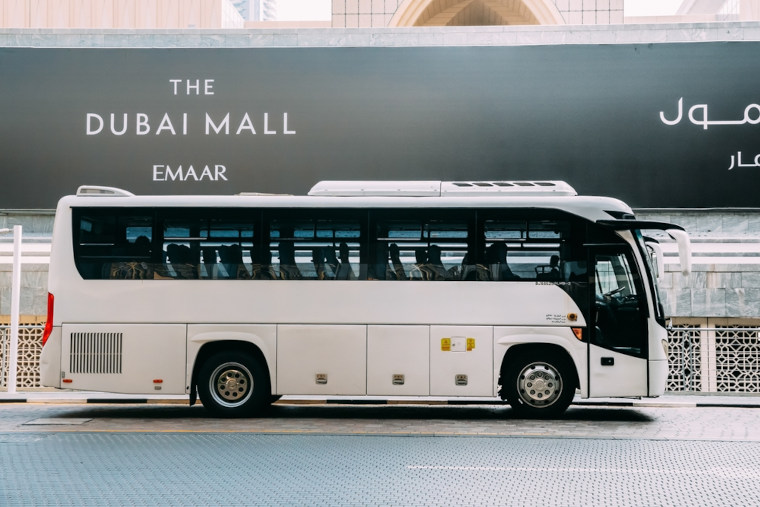

18.09.2025
1277
What are they like? Buses in Dubai are comfortable, with air conditioning and Wi-Fi. Riding them is a true pleasure. Overcrowding and theft are unthinkable. Many tourists and almost all local residents are confident, and not without reason, that this type of urban transport is far superior to its European counterparts.
What to pay attention to? The Arab Emirates is a Muslim country, and the laws there are very strict. Inappropriate behavior in public places, which includes buses, is punishable by substantial fines.
Infrastructure, business, and tourism in Dubai are developing at a great pace. However, the issue of traffic jams remains acute for many years. Along with the emirate's growth, the number of motorists is increasing. For convenience, there are separate lanes for public transport.
During rush hours, it's more comfortable to travel by bus than by taxi or rental car. You'll save both time and money. Buses in Dubai are the most budget-friendly mode of transport.
Bus service covers 90% of the city. This means you can get to almost any point.
You won't have to wait long for transport at the stop because more than 1,500 vehicles circulate on the streets. Some of them follow express routes, allowing you to travel quite quickly. Some intersect with metro stations, which means you can plan a budget route with transfers.
 Image source: Philip Lange / shutterstock.com
Image source: Philip Lange / shutterstock.com
In Dubai, you won't have to worry about what time the buses run until and whether you'll make it back in time. City transport operates in two shifts. Day buses run from 5 AM to midnight. There are also special night routes: from 11 PM to 6 AM.
The entire bus network is managed by the Road and Transport Authority (RTA). It provides transportation within Dubai and beyond. 12 out of 119 routes are intercity, which is convenient in case you want to leave tourist places and better understand UAE culture.
A safe and comfortable journey is guaranteed. Buses in Dubai are equipped with Wi-Fi and air conditioning. There are also cooling systems at the bus stops. Due to this, both waiting for transport and the journey itself are quite easy to bear.
An important question: how to pay for buses in Dubai? Don't even try to ride without a ticket because laws are strictly enforced in the Emirates. Conductors board the buses and fine fare dodgers, so it's better not to risk it. It’s best to purchase a unified Nol Card travel pass. They are sold at metro stations, bus stops, and special machines.
Nol Cards work the same way as our "Troika": you add funds to the balance and pay for travel on any transport. Place your Nol card to the validator and remove it immediately. If held for too long, the system might count this as both the start and the end of the journey.
By the way, there's a 30-minute rule in the transport system. If you manage to transfer from one transport to another within this time, it counts as one journey, and you pay only once. Bus fare in Dubai depends on how many zones you cross (there are 7 in total in the city). Children under 5 years old and under 90 centimeters in height have the right to travel for free.
Additionally, if you decide to use buses in Dubai, remember that the driver may pass a stop. If you see the transport you need, wave your hand. And if you need to get off, press the special button in advance.
In the Arab Emirates, there are many laws and rules that are in your interest to follow, as the slightest violation is subject to a fine.
There is a separate set of requirements for public transport passengers:
There are also larger penalties. For example, carrying weapons, leaving trash, or attempting to argue with the driver/conductor/inspector can result in a fine of 100 AED (2,400 rubles).
And for fare evasion or paying with an expired card — 200 AED (4,800 rubles). By the way, if you threw away your bus ticket in Dubai but haven't finished your route, you'll be considered unpaid. This can also result in a 200 AED fine.
You cannot buy a bus ticket in Dubai with cash. You need a special Nol pass. If traveling with family, each person must have a separate card. There are different types of cards: red, blue, silver, and gold. The bus fare in Dubai depends on the color of the Nol Card and Dubai's transport zone:
Its validity period is 90 days or 10 trips. It’s suitable if you don't plan to use public transport frequently. You can buy it at special vending machines or ticket sales points. You can also top it up there. Online money transfer to the red card is not possible. You can top it up with a maximum of 10 trips at once.
The cost of a red Nol Card in 2024 is 2 AED (plus there must be an amount equal to at least 1 trip on the balance). Bus fare in Dubai for it in 2024:
 Image source: pio3 / shutterstock.com
Image source: pio3 / shutterstock.com
If you have a red card but want to ride in a premium metro car, the fare is twice as expensive. Another option is to purchase a gold card, information about which can be read below.
It’s difference is that you can also use it to pay for parking. Limits are also increased: Silver Nol Card can be topped up with 1000 AED, online money transfer is available. Such a card costs 25 AED (19 AED remains on the balance). You can buy it at special vending machines, ticket sales points, and RTA offices. This option will suit you if you plan to use public transport frequently.
Travel cost with Silver Nol Card:
The main difference between the gold card and the silver one is the ability to ride in premium metro cars.
You can buy a gold ticket for Dubai buses at the same places as others, as well as at metro ticket offices and online. Its cost is 25 AED (19 AED remains on the balance). Validity period — 5 years.
Gold card fare in 2024:
 Image source: frantic00 / shutterstock.com
Image source: frantic00 / shutterstock.com
There is also a blue travel card, but it's useless for tourists. Only UAE citizens can use it, and not all of them. It's intended only for students, pensioners, and disabled people.
Dubai bus schedule and routes can be viewed through the special S'hail application (available on AppStore and GooglePlay). You can also use the Dubai government website. There is a section dedicated to public transport. Fill in the details: starting point, destination, date and time of your intended travel. The service will provide optimal routes with prices and schedules.
Schedule of buses on Dubai's most popular routes:
If you go on a trip in the spring, you might get there during Ramadan. The days of the beginning and end of the holy month in Islamic countries are considered holidays, and because of this the public transport schedule often changes. Information about this can be found on the official government website or on special stands located at bus stops.
By the way, most hotels have their own buses. At a certain time, they take guests to the beaches and the city center. You can find out whether this service is available to you at the reception.
Special tourist buses run through Dubai's most famous places. They work on the "Hop-on, hop-off" principle: you buy a ticket and can enter/exit unlimited times. Dedicate a day to a sightseeing tour, exploring the attractions at each stop, and then board another bus following the same route.
There are also the famous red buses in Dubai. These are double-decker buses running 24 hours a day. During the journey, you can listen to an audio guide about attractions, history, and culture of the country (available in 12 languages, including Russian).
Bus tour cost in 2024:
When ordering the tour online, there's a 20% discount. Adult and child tickets will cost $71.1 and $47.8 respectively. Child tickets are for passengers from 5 to 15 years old. For those who are under 5 years old the tour is free. Tickets are valid for 6 months from the purchase date.
Guests can choose from 2 routes:
More information can be found on the company's official website or in the Big Bus Tours mobile app, available for iOS and Android.
Double-decker tours are also organized by another company — City Sightseeing Dubai. On such a bus, you can ride for one day or go on a tour lasting up to a week. Ticket prices start from 180 AED, with discounts for children of 6–11 years old.
The most popular type of transport in Dubai is the metro. High-tech trains run without drivers and allow quick access to main shopping centers and business districts.
However, the metro network doesn't reach all tourist spots. For example, it's 3 kilometers from the metro station to the beach. Walking is not the best option. Better to take a comfortable bus with air conditioning.
Here's how to get to attractions not reached by metro:
Route passes through city beaches. You can also reach Wild Wadi water park, the sea-standing Burj Al Arab hotel, and the monorail on Palm Jumeirah.
Its route goes through the Deira district and covers almost all popular hotels. You can use it as an alternative to transfer.
If you live near the red line of Dubai metro, this route can take you to one of the most famous public beaches, La Mer. There are many cozy restaurants, water activities, and the Laguna water park.
If you're staying near the Mall of the Emirates, this route is an excellent opportunity to quickly reach beaches and attractions without spending a fortune. The bus goes down to Madinat Jumeirah resort, a water park, "The Sail," and entertainment district City Walk.
Final stop — the famous Dubai Mall. There are always many tourists because shopping in Dubai is cheaper than in other developed countries, as the country has a lenient tax policy.
 Image source: George Trumpeter / shutterstock.com
Image source: George Trumpeter / shutterstock.com
Shopping lovers should keep in mind other routes. Buses 66 and 67: these are the only ones that can take you to Dubai Outlet Mall.
And on buses 104 and 105, you'll reach the Global Village international fair and the world's largest flower garden. Miracle Garden today has more than 45 million plants.
These are just some of the popular routes. Dubai has more than a hundred. Therefore, it's better to set the desired destination and check the schedule in the app or on the website before traveling.
The operating principle is indeed similar: it's a card that can be used to pay for travel on any type of public transport. The only difference is that all "Troika" cards are the same, while Nol Cards come in different types. Silver ones allow you to pay for parking, while gold ones, among other things, provide access to premium-class metro cars.
Firstly, it's unethical. Secondly, it is in your best interest to abide with the law in the Emirates. Conductors can board at any time and check if you tapped your card at entry. If not, fines can reach up to 200 AED (about $50). When paying for the ride, the validator issues a receipt. Keep it until the end of your journey. If you don't have it, you may be considered a fare dodger.
They are very convenient but not the cheapest option. If you are traveling with your family, you'll have to spend around a hundred dollars. If you want to save money, study the public transport network. In terms of comfort, they are no different from tour buses: there's air conditioning everywhere, and order is carefully maintained.
The only difference: you'll travel through public places without a guide. But you can study information in advance independently, and for example, take a guide in museums. This way it will be more cost-effective and even more interesting.
You can reach the main tourist spots by water too. There are 4 options: water taxi, ferry, abra, and water bus. Abra is an Arabic boat that's considered not only a mode of transport but also an attraction. If 20 passengers gather, the fare will be just 1 dirham.
And the water bus is a modern equivalent of abra. Passengers are transported in an air-conditioned glass cabin. Dubai water buses depart every 15–20 minutes. Tickets can be bought at stations, fare varies between 2–11 dirhams depending on route length and number of stops.
From Dubai, you can reach neighboring emirates by this type of transport: Abu Dhabi, Fujairah, Sharjah, Ajman. All intercity routes have the letter "E" in their name: E8, E72, etc.
You can reach all interesting places by bus in Dubai. Routes pass through city beaches, entertainment centers, water parks, business districts, and attractions. Order in the cabins is strictly monitored, so the journey will be comfortable.
And public transport is not only a way to save budget but also an opportunity to get closer to Arab culture, its rules, and people.
Article header image source: ad-foto / shutterstock.com